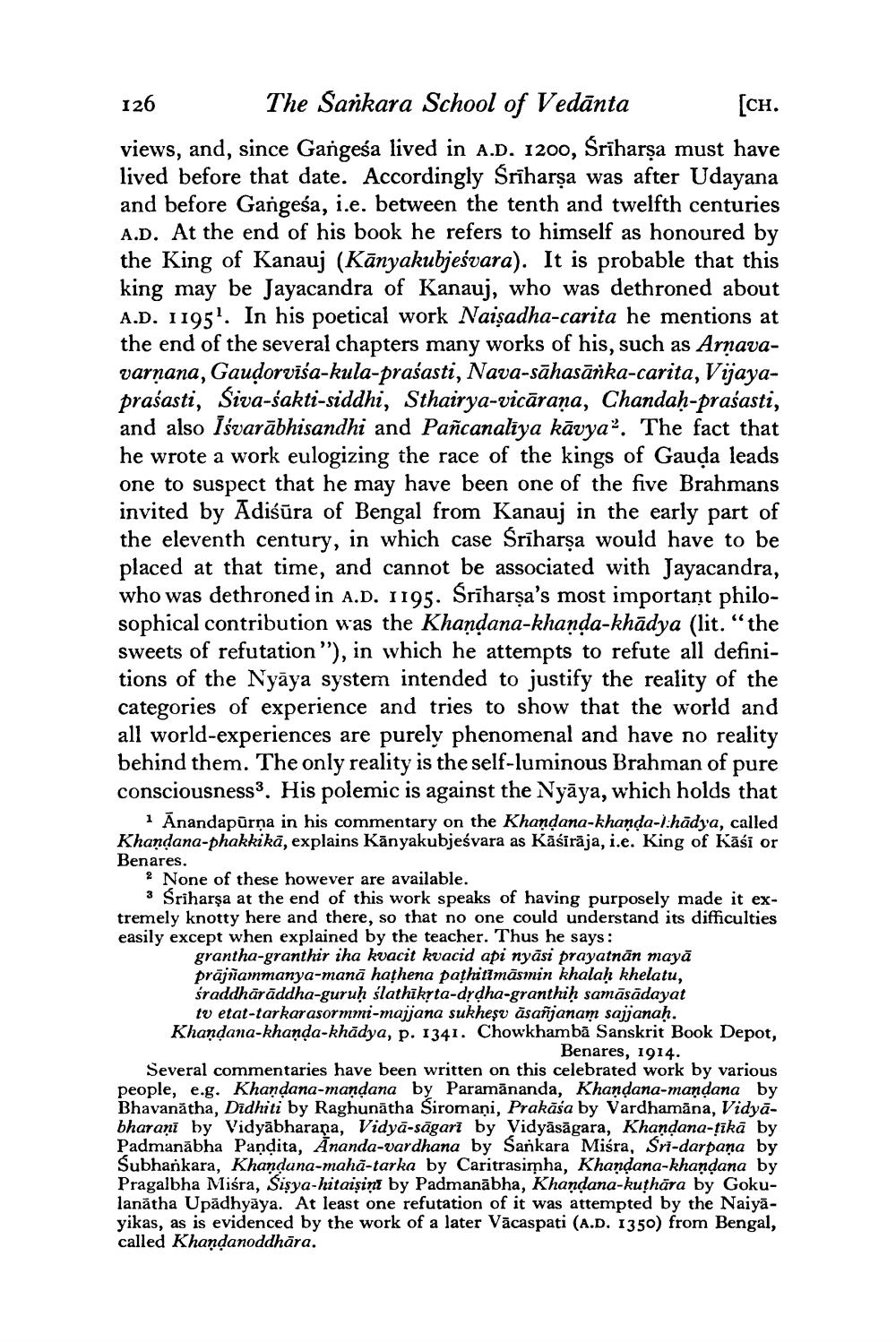________________
126
The Sankara School of Vedānta [CH. views, and, since Gangeśa lived in A.D. 1200, Śrīharṣa must have lived before that date. Accordingly Śrīharşa was after Udayana and before Gangeśa, i.e. between the tenth and twelfth centuries A.D. At the end of his book he refers to himself as honoured by the King of Kanauj (Kānyakubjeśvara). It is probable that this king may be Jayacandra of Kanauj, who was dethroned about A.D. 1195?. In his poetical work Naişadha-carita he mentions at the end of the several chapters many works of his, such as Arnavavarnana, Gaudorvīša-kula-prasasti, Nava-sāhasānka-carita, Vijayapraśasti, siva-sakti-siddhi, Sthairya-vicāraṇa, Chandah-prasasti, and also īśvarābhisandhi and Pañcanalīya kāvya". The fact that he wrote a work eulogizing the race of the kings of Gauda leads one to suspect that he may have been one of the five Brahmans invited by Adiśūra of Bengal from Kanauj in the early part of the eleventh century, in which case Sriharșa would have to be placed at that time, and cannot be associated with Jayacandra, who was dethroned in A.D. 1195. Śrīharşa's most important philosophical contribution was the Khandana-khanda-khādya (lit.“the sweets of refutation"), in which he attempts to refute all definitions of the Nyāya system intended to justify the reality of the categories of experience and tries to show that the world and all world-experiences are purely phenomenal and have no reality behind them. The only reality is the self-luminous Brahman of pure consciousness. His polemic is against the Nyāya, which holds that
1 Anandapūrņa in his commentary on the Khandana-khanda-l:hadya, called Khandana-phakkikā, explains Kānyakubjeśvara as Kāśirāja, i.e. King of Kāśi or Benares.
2 None of these however are available.
3 Sriharşa at the end of this work speaks of having purposely made it extremely knotty here and there, so that no one could understand its difficulties easily except when explained by the teacher. Thus he says:
grantha-granthir iha kvacit kvacid api nyāsi prayatnān mayā prājňammanya-manā hathena pathitimāsmin khalah khelatu, sraddhārāddha-guruḥ ślathikyta-drdha-granthiḥ samāsādayat
tu etat-tarkarasormmi-majjana sukheşv asanjanam sajjanah. Khandana-khanda-khādya, p. 1341. Chowkhamba Sanskrit Book Depot,
Benares, 1914. Several commentaries have been written on this celebrated work by various people, e.g. Khandana-mandana by Paramānanda, Khandana-mandana by Bhavanātha, Dīdhiti by Raghunātha Siromani, Prakāśa by Vardhamāna, Vidyabharaṇī by Vidyābharana, Vidyā-sāgari by Vidyāsāgara, Khandana-țīka by Padmanābha Pandita, Ananda-vardhana by Sankara Misra, Sri-darpana by Subhankara, Khandana-mahā-tarka by Caritrasimha, Khandana-khandana by Pragalbha Miśra, Sisya-hitaişint by Padmanābha, Khandana-kuthāra by Gokulanātha Upadhyāya. At least one refutation of it was attempted by the Naiyāyikas, as is evidenced by the work of a later Vācaspati (A.D. 1350) from Bengal, called Khandanoddhāra.




